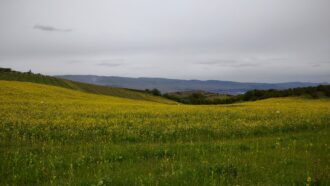Eighty percent of Oregon’s cherries are produced in the Mid-Columbia Basin. Typically, when new orchards are planted, farmers leave the ground under the trees bare or plant grass. Farmers also regularly apply chemicals to control insect pests such as spotted wing drosophila, thrips, and leafhoppers, among others. However, planting mixed cover crops that include flowering plants in new orchards may provide habitat for diverse beneficial invertebrates (beneficials), some of which play key roles in pest control. When farmers consider planting cover crops, they must decide on a seed blend to use, despite scarce information on how different blends influence beneficials. Nearby natural habitats, such as native oak land, also harbor beneficials, which likely provide additional pest-control services to neighboring orchards.
To provide better understanding of how cover crops and natural habitats can support beneficial insects, Oregon State University graduate student Scott Mitchell examined how communities of beneficials are influenced by different cover crop blends, both in out of rotation orchards, newly planted orchards, and adjacent natural habitats.
He did so by inventorying non-pollinator beneficials in orchards and natural habitats and examining habitat characteristics associated with their distribution and community composition. The goal of his work is to determine the ability of different cover-cropping regimes (no cover crop vs. grass dominant cover crops vs. a grass and forb mixed cover crops) to enhance beneficials communities and to investigate the ability of different cover-cropping regimes to reduce the abundance of pests. The field work was conducted in two farmers’ orchards; one of whom was very involved by paying for the seed, leading the field design, and acting as a member of the project team.
A recommendation that arose from the study was to mow the cover crops less frequently or to set mowers to a higher height.
“Cover crops that flower and attract beneficials cost more than grass cover crops. Mowing less often or at a higher height means not knocking off the blooms, which are important resources for beneficial insects. It defeats the purpose of planting expensive seed blends to mow too low. There can be reasons to mow lower. So, delaying can be important,” says Mitchell.
Mitchell also became aware of how dry native plant communities are by mid-summer in the Dalles. In May and June, flowering plant communities are impressive, containing many species of blooming plants that produce abundant wildflowers and host beneficials. These habitats are important for biodiversity in this landscape, since there are many native plant and insect species that were only found in these native habitats.
While the data is still being analyzed, Mitchell has also noticed a surprising preliminary result. In young orchards where no cover crops had been planted, yet plants under the trees were allowed to grow, there was still a strong diversity of blooming plants hosting diverse ground beetles.
“A lot of these plants are weedy plants, and I expected the ground in these sites to remain bare throughout the season. But I was seeing flowers with critters moving around,” says Mitchell.
Mitchell has experienced interest from farmers and has plans for additional outreach such as posting videos, writing extension documents, and connecting with growers at conferences and farm days.
“The research has been broadly interesting to farmers, not just those with orchards. We’ve also found interest from NRCS practitioners and extension specialists.”
